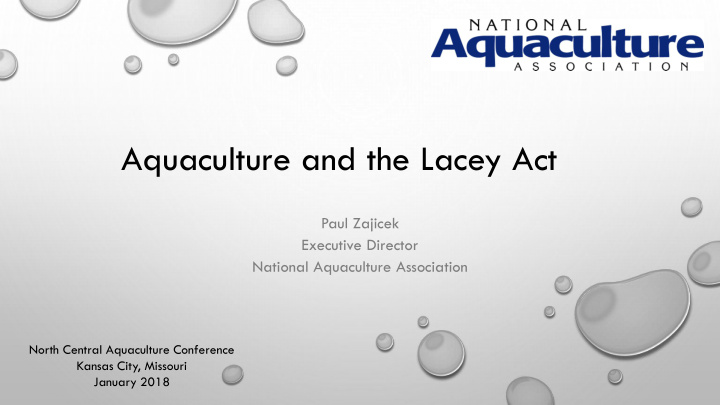



Aquaculture and the Lacey Act Paul Zajicek Executive Director National Aquaculture Association North Central Aquaculture Conference Kansas City, Missouri January 2018
National Aquaculture Association One Strong Voice, One Strong Industry • Farmer formed in 1991. • Labor, Agricultural and Horticultural Organizations: 501(c)(5) non-profit trade association • Board of Directors: 18 members To provide a unified national voice for aquaculture that ensures its sustainability, protects its profitability, and encourages its development in an environmentally responsible manner.
Lacey Act America’s first conservation legislation passed in 1900 • Supported State Wildlife Regulations • Labeling Requirement • Prohibited Injurious Wildlife Importation
Lacey Act circa 2017 • Support foreign, federal, state and tribal natural resource laws • Injurious wildlife listings: 449 species of birds, mammals, fish, amphibians, crustacean and reptiles • Interpreted to prohibit interstate trade in injurious wildlife. • Extremely punitive punishment (fines and prison)* *SRAC Publication No. 5005, Aquaculture and the Lacey Act
US Association of Reptile Keepers (USARK) • December 2013 , USARK challenges USFWS interpretation of Lacey Act that the agency can prohibit continental interstate transportation of four large snakes listed as Injurious Wildlife. • March 2015, USFWS lists four more large snakes as Injurious Wildlife • April 2015, USARK Amends Complaint • May 2015 , DC District Court found in favor of USARK. • May 2015 , Dept of Justice filed an appeal to the DC Circuit. • April 2017 , DC Circuit upheld the DC District Court.
CISP Petition • September 2016 , Center for Invasive Species Prevention (CISP) petitions USFWS under the Lacey Act to list 43 native and nonnative species as Injurious Wildlife. • Proposed species include black acara, blue catfish, common carp (i.e., koi), grass carp, guppies, Jaguar guapote, three plecos (Amazon, Orinoco and vermiculated sailfin catfish), red swamp crawfish, and three tilapias (i.e., blue, Mozambique and Nile). • Petition based upon “high risk” result of USFWS posted quick ecological risk screens • The NAA creates a coalition and campaign to inform the USFWS.
Practical Effects • The USFWS no longer has the authority to prohibit continental interstate transport of injurious wildlife. • A variety of NGOs are supporting an effort to create that authority. • The court ruling did not change how the Lacey Act supports foreign, federal, state or tribal natural resource laws. • Informal decision by USFWS not to act upon the Petition.
NAA Lacey Act Coalition • Amend the definition of “fish or wildlife” in 16 U.S.C. 3371 to exclude farm -raised animals. • Reaffirm the intent of Congress to prevent the import of “injurious” wildlife. • Delete FWS authority to regulate salmonid diseases described in Title 50 of the Code of Federal Regulations. Create this authority and transfer the funding to the U. S. Department of Agriculture, Veterinary Services (USDA VS). • Create a process that includes a definitive timeframe for conducting science-based risk analyses to list a species as injurious wildlife, including the involvement of key stakeholders. • Create the means to directly and effectively address invasive species by providing federal technical expertise to the states to identify, prevent, manage or control species.
Questions? naa@thenaa.net Office: 850-216-2400 Cell: 850-443-3456
Recommend
More recommend